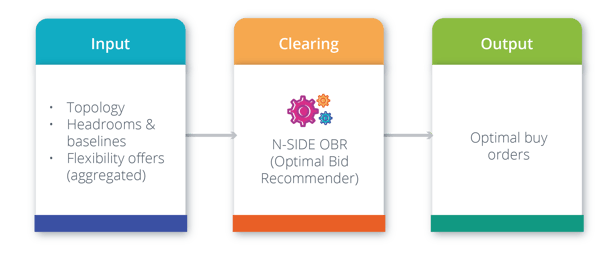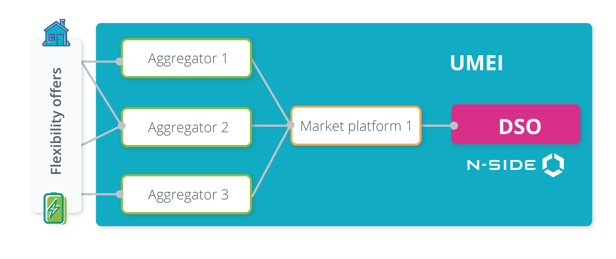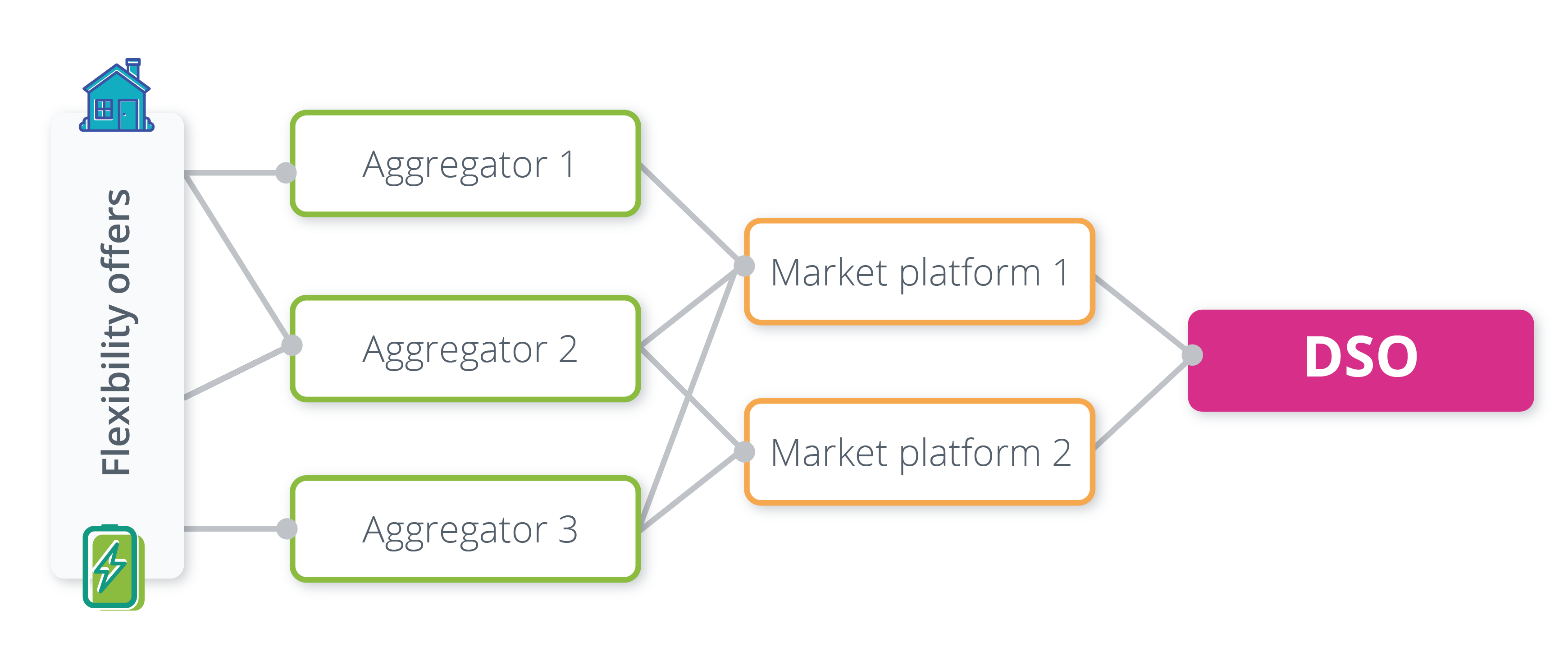Professional Services
Whether your challenge can be solved by our existing products or requires the development of new analytics solutions and market design approaches, our team is ready to help.
How to reconcile the sensitivity of system operator data with efficient grid-aware markets?


EUniversal German demonstrator
This article is part of a broader series linked with the EUniversal Project and how N-SIDE is helping 3 major DSOs to simplify communications. You can find the first article introducing the global context here.
The new local consumption and production patterns from residential consumers pose a significant challenge for DSOs in managing their power grid effectively. To avoid costly reinforcements in order to cope with very local issues, relying on residential flexibility is envisioned through market approaches.
The EUniversal project proposes to manage this problem via market solutions with the particularity of relying on a common European standard (called UMEI) to communicate with multiple flexibility market platforms simultaneously.
In this episode, we will focus on the concrete setup around the flexibility procurement of Mitnetz, an important German DSO. We will examine how they managed to use grid-aware markets without compromising the sensitivity of the data.
Mitnetz challenges
Mitnetz is a major Distribution System Operator based in East Germany. It is responsible for supplying electricity to 2.2 million consumers. Its grid area covers 30,804 km2 and consists of mainly rural conditions with a high share of renewables. The installed capacity of renewable energy reached more than 10 GW in 2021.
Mitnetz is convinced that market-based congestion management and voltage control has a big potential. This is the reason they have taken part in the H2020 Sysflex project and are now involved in EUniversal. However, during the market design phase, a key challenge was identified to leverage N-SIDE technology capabilities to solve Mitnetz issues in a cost-efficient way: regulation around the grid data.
The problem lies in the sensitivity of Mitnetz grid data and its regulation which are preventing the DSO to share most of it to any external entity, in this case a market platform.
As a reminder from episode 2, a market platform is a central entity whose role is to centralise the needs and offers for actors willing to buy or sell their assets. In this/our context, the assets are flexibility needs (coming from the DSO) that are traded with the flexibility offered by the aggregators.
In practice, this means that market platforms providers cannot have access to detailed DSO grid data. Therefore, the market platforms can only consider groups of assets that lie in the same area. The zones are rather “big” and neglect local grid details. This tends to be a problem when very local problems find most efficient solutions through concentrated flexibility. In the context of local markets at lower voltage, location even within a street is crucial.
To take the locational information into account, Mitnetz could create bids based on pessimistic scenarios (i.e. considering that the bids are always located in the least-efficient part of the zone) and choose a continuous market where they can select the orders to activate based on their positioning within the grid. However, conducting this kind of locational analysis at scale is cumbersome. Moreover, this approach means dropping the advantages of auction based markets.
Recognizing the economic welfare gap between these two solutions compared to an idealised one that combines their benefits, N-SIDE in collaboration with Mitnetz deep dived into the topic to develop a way more effective alternative.
It is worth noting that our challenge extended beyond the specific case of Mitnetz, raising a broader question: "How can a system operator handle grid-related information without sharing it on a market platform, while still using this data in an automated way when choosing what to activate?"
N-SIDE Solution
A series of discussions with Mitnetz allowed us to grasp their limitations and emerged in the creation of the N-SIDE Optimal Bid Recommender (OBR), a tool running at the DSO premises.
⚙️ The tool takes as input DSO grid data and flexibility offers from the market and performs a “virtual market clearing” aiming at minimising activation costs while bringing the network back in a safe operation zone. Results are then made available for Mitnetz who will check them and forward them to a central continuous Market Platform.

This solution made our role in the project evolve from a market platform to a provider of a tool for DSOs. This reflects in the following way on our usual diagram:

Recognized Innovation
What initially seemed like an impasse, with the challenge of creating efficient grid-aware markets without losing control on critical system operator data, led us to a clever solution that is simple to implement and that combines the advantages of all approaches without bringing their drawbacks.
Mitnetz - who has had the chance to benefit from the tool for more than a year now - appreciates the innovation of the N-SIDE Optimal Bid Recommender, from its design to its industrial implementation and maintenance:
“The flexibility of N-SIDE enables Mitnetz to solve the challenging situation of running an optimised market clearing without having to share any sensitive grid data. To achieve this, the N-SIDE team showed inventiveness and know-how from the market design part down to the full implementation of a reliable tool we can count on.”
David Brummund, R&D Coordinator at Mitnetz Strom (E.ON group) and Leader of the German demonstrator in EUniversal
Moreover, this innovation culminated in an academic paper presented at CIRED 2023, where it was selected for a on-site presentation.
Co-Author
Pierre Crucifix is an Engineer and Economist active in market-oriented activities at N-SIDE. He has contributed to some Euphemia R&D achievements and to the deployment of our Power Matching Algorithm in India. He has also worked for system operators by designing and delivering solutions for local and balancing markets. Pierre is now the Product Manager of the N-SIDE Power Matching Algorithm, shaping how our market clearing offer can evolve to allow even more end-consumers worldwide to get access to cheaper and cleaner electricity.
The Euniversal Series
The new local consumption and production patterns from residential consumers pose significant challenges for DSOs in managing their power grid. To avoid costly reinforcements in order to cope with very local issues, relying on residential flexibility is envisioned through market approaches.
The EUniversal project proposes to rely on a common standard at European level to ease market interactions. Adopting it will prevent an unstructured IT setup that leads to vendor lock-in, hindering flexibility and market competition before it is too late.
Through this series, learn more about the problem, how the solution was designed and how it is used by major DSOs in Europe.
- How N-SIDE helps DSOs take the most of various sources of flexibility simultaneously: the EUniversal project
- The UMEI - How a European standard is simplifying DSO interactions with local markets.
- How can a DSO manage simultaneously grid planning, scheduled maintenance and congestion management via market solutions?
- How to reconcile the sensitivity of system operator data with efficient grid-aware markets?
This project has received funding from the European Union’s Horizon 2020 research and innovation program under grant agreement No 864334.
This article reflects only the N-SIDE view. The European Commission Innovation and Networks Executive Agency is not responsible for any use that may be made of the information it contains.




















